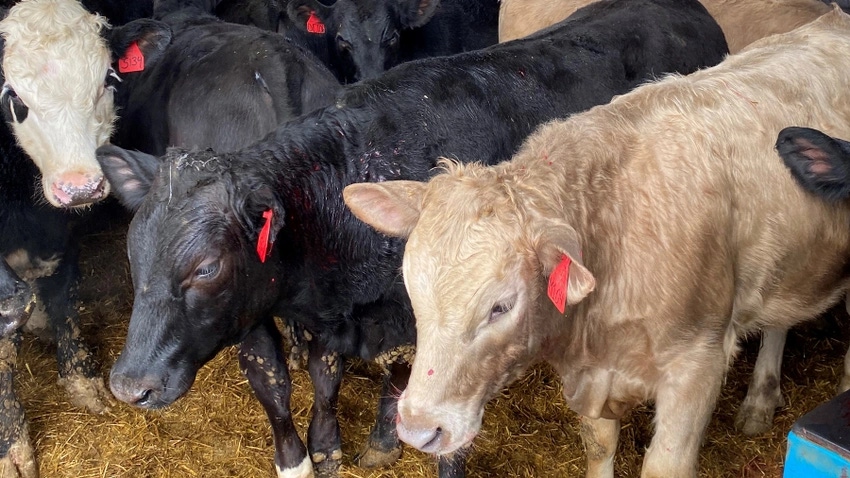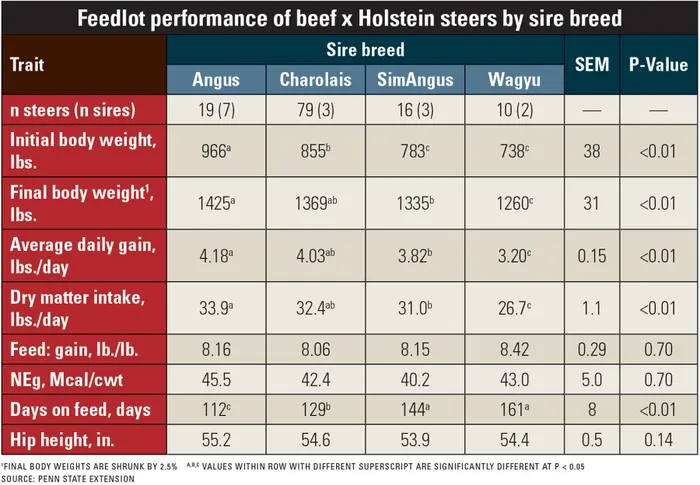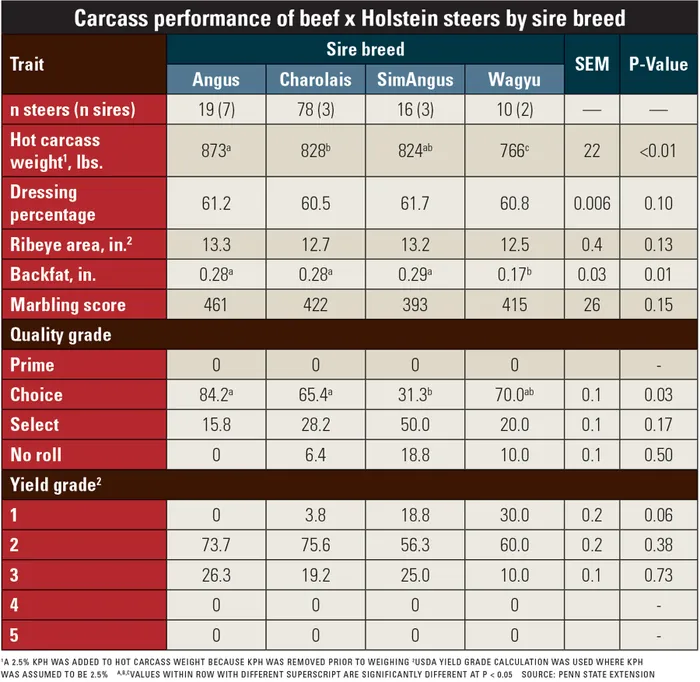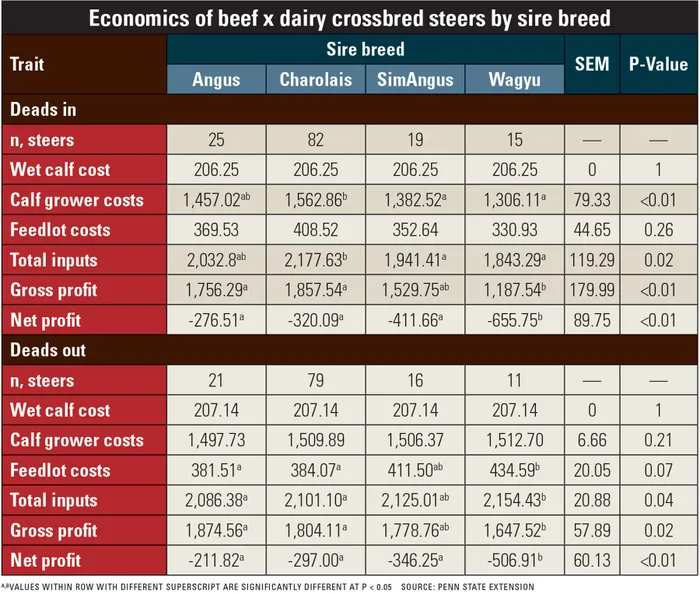The third year of a Penn State trial looked at feedlot performance and economics.
March 13, 2023

Penn State has completed the third year of a four-year feedlot trial looking at the optimal genetics of beef-sired steers born to Holstein dams.
The prevalence of beef-on-dairy matings continues to grow. In 2021, 8.7 million units of beef semen were sold domestically, up 20% from 2020.
Penn State researchers have continued evaluating beef-Holstein steers. These efforts are supported by USDA’s Critical Agricultural Research and Extension, with additional support from JBS and Premier Select Sires.
Research animals were finished at the Pennsylvania Department of Agriculture’s Livestock Evaluation Center feedlot. Beef-Holstein bull calves sired by Angus, Charolais, SimAngus and Wagyu bulls born on Pennsylvania dairies from May to August 2021 were transported to one of two calf-growing facilities within one week of birth.
These calves were fed milk replacer and free-choice starter grain until weaning at about 7 weeks of age.
After weaning, calves were consolidated to one facility and fed a growing ration. They were implanted with Synovex-C in November and implanted with Synovex-S in February.
After initial grow-out, 19 Angus-Holstein, 79 Charolais-Holstein, 16 SimAngus-Holstein and 10 Wagyu-Holstein steers were brought to the center. Steers were fed a common corn and corn silage-based diet, and slaughtered after 90, 118 or 153 days on feed at the center.
Groups were selected for slaughter based on a combination of visual appraisal and body weight.
Initial and final weights are reported as a two-day average body weight at the beginning and end of the center feeding period, respectively. Average daily gain was calculated as the difference between initial and final average body weight divided by the total days on feed.
Growth performance of the steers by sire breed is reported below:

Angus-sired steers were heaviest at feedlot entry — 966 pounds — and were fed at the center for the fewest days — 112. SimAngus and Wagyu-sired steers were the lightest at feedlot entry — 783 and 738 pounds — and on feed the most days — 144 and 161 days, respectively. Charolais-sired steers outperformed the Wagyu and SimAngus steers but were still inferior to Angus.
Angus-Holstein steers were heavier at slaughter than SimAngus and Wagyu-sired steers. The disadvantage Wagyu-sired steers had in feedlot growth performance was due, in part, to their reduced dry matter intake and average daily gain when compared to progeny of other sire breeds.
Because the cattle that consumed less feed grew slower, no breed differences existed in feed conversion to gain (about 8 pounds of feed for 1 pound of gain). Additionally, there were no differences between sire breeds in hip height at harvest.
Yearling height is included in the $AxH index. While the Angus sires used in this project were not specifically selected using the $AxH index, height has been of interest to ensure beef-dairy crossbreds are not too large for meat packers to accommodate.
Despite the growing popularity of Wagyu genetics in the U.S., carcasses from Wagyu-Holstein steers were the lightest and had the least amount of backfat of any sire breed used, as seen in the table below:

Dressing percentage tended to be least in carcasses from Charolais-Holstein steers (60.5%) and in carcasses from SimAngus-Holstein steers (61.7%). Carcasses from Angus- and Wagyu-sired steers were intermediate and not different.
About 84% of Angus-Holstein steers graded Choice, while only 31% of SimAngus-Holstein steers graded Choice. However, there were no differences in marbling scores between sire breeds. Most carcasses from beef-Holstein steers were Yield Grade 2.
Evaluating the economics
Although the project looked at economics by sire breed, it is important to recognize that this research represents a snapshot in time rather than a continuous production system. Because death loss represents a big expense that is highly variable between farms, economics are presented in two ways:
• with the costs associated with calves that died accounted for (deads in)
• with the costs associated with calves that died removed (deads out)

Input costs included wet calf price, which ranged from $200 to $250, calf grower costs, and feedlot feed and yardage expenses.
Gross profit was calculated using quality and yield grade grid pricing at time of harvest and based off the distribution presented in the second table in this column. Grades were called by trained research staff at the plant.
Wagyu underwhelms
Net profit was calculated as the difference between gross profit and inputs. In both analyses, net profit was negative for all sire breeds, and Wagyu-Holstein steers resulted in the greatest economic losses.
Despite most Wagyu-Holstein carcasses avoiding quality grade discounts and achieving yield grade premiums, reduced carcass weight compared to the other breeds significantly affected gross profit.
Conversely, despite most SimAngus-Holstein carcasses receiving quality grade discounts, their gross profit did not differ from that of Charolais-Holstein carcasses or Angus-Holstein carcasses.
While statistically losses were not different across cattle sired by Angus, Charolais or SimAngus, the Angus-Holstein steers, numerically, lost the least amount of money.
Explaining net losses
The lack of profit among all groups of steers suggests that the profit margin for beef-Holstein calves was slim in 2022. However, caution should be taken that cost reduction does not affect growth efficiency or carcass performance.
Calf grower costs are the largest input cost and contributed to variation between sire breeds in the deads-in model because a greater proportion of Angus, SimAngus and Wagyu-sired calves died at the calf grower than Charolais-sired calves did and, therefore, had fewer calf grower feed and labor expenses.
It is possible that costs could be reduced on the dairy or in commercial settings if access to more affordable inputs, such as waste milk, are available.
For 2022, Wagyu-Holstein steers had the greatest economic losses because of their inferior average daily gain and dry matter intake on the feedlot, greater days on feed, and reduced carcass weights in comparison with steers of other sire breeds.
The final group of beef-Holstein steers will be finished this summer, and the results will be combined with the results from previous years to produce a final comparison of beef sire breeds.
Felix is a beef specialist with Penn State Extension.
You May Also Like



